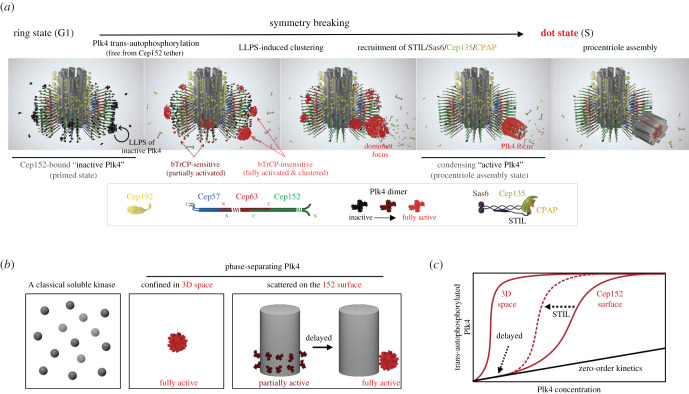Figure 4.
Symmetry-breaking of Plk4 on the cylindrical Cep63-Cep152 assembly, and its biochemical significance. (a) In G1, a fraction of Cep152-bound inactive Plk4 (i.e. ring-state Plk4) may stochastically cross a critical point of phosphorylating the CPB, thus causing the enzyme to undergo LLPS, generating patches of Plk4 condensates [38]. Based on the data obtained with the N-terminal fragment of Plk4 [37], catalytically inactive Plk4 (indicated by a black dimer) may also possess the LLPS capacity (circular arrow, first panel), which may help active Plk4 to generate condensates through a lateral inhibition self-patterning process [37,49]. A single Plk4 focus (i.e. dot-state Plk4) is thought to ultimately emerge from subsequent amplification and competition processes [49,75]. Condensed active (red, shown in cluster), but not partially active (dark burgundy), Plk4 could evade βTrCP-mediated suicidal degradation [38]. Incoming STIL, which activates Plk4 [76,77], can reinforce the Plk4's ring-to-dot conversion process under these circumstances. The dot-state Plk4 serves as an assembly matrix for centriole biogenesis. (b,c) A monomeric soluble kinase autophosphorylates its intramolecular target site (b, first panel) with zero-order kinetics (c, linear line). If Plk4 is at a sufficient concentration in a confined 3D space, its catalytic activity-dependent LLPS activity would enable it to cooperatively generate trans-autophosphorylated products as the enzyme becomes active over time (b, second panel), thus exhibiting sigmoidal kinetics (c, curved line marked ‘3D space’). Tethering Plk4 around the cylindrical Cep152 is expected to delay the early clustering process (b, third panel, and c, curved line marked ‘Cep152 surface’), providing a window of time to properly regulate Plk4's ring-to-dot relocalization while filtering out under-threshold (i.e. noise) Plk4 clusters. STIL could enhance the cooperative production of trans-autophosphorylated Plk4 and subsequent condensation by activating Plk4, thus augmenting the sigmoidal reaction kinetics (c, dotted arrow).

